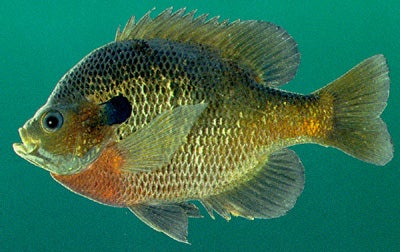SCIENTIFIC NAME:
Lepomis macrochirus
CHARACTERISTICS:
The bluegill has 39 to 44 lateral line scales. Its dorsal fin contains nine to 11 spines and 10 to 12 soft rays, its anal fin three spines and 10 to 12 rays. The pectoral fin is long and pointed, extending past the eye when bent forward. The mouth is small; the upper jaw does not extend to the front of the eye. Always black, the flexible ear flap is small in juveniles, longer in adults. Juveniles and nonbreeding adults are light olive to gray on the back and sides with several evenly spaced, darker vertical bands. The venter varies from pale yellow to white. All but small individuals have a distinct black spot toward the rear of the soft dorsal fin. Breeding males darken, with the back and sides becoming purple.
ADULT SIZE:
6 to 10 in (152 to 254 mm).
STATE RECORD:
a list of the State Record Freshwater Fish.
DISTRIBUTION:
Introductions into lakes and rivers have expanded this species’ native range across the United States and into southern Canada and northern Mexico.
HABITAT AND BIOLOGY:
Bluegills occur throughout Alabama in springs and small streams to large rivers, reservoirs, swamps, and private ponds. A protracted spawning season lasting from April into September produces millions of bluegill in Alabama each year. Nests are prepared on shallow sand and gravel bars in small to medium streams. Hundreds are constructed in shallow backwater areas of rivers and reservoirs, frequently near largemouth bass nests. Bluegill are routinely stocked in lakes and ponds as food for largemouth bass. They are an excellent game fish, especially for young anglers, and their white, flaky meat is quite tasty. Bluegills are density dependent, meaning that as their numbers increase (within limits), their relative sizes decrease. It is therefore imperative to catch and remove smaller fish to avoid overpopulation. Uncorrected overpopulation can adversely affect the age-class structure of largemouth bass populations and eventually take the lake out of balance. Bluegill live for five to six years in Alabama. The largest individuals usually come from well-managed lakes.
ORIGINAL DESCRIPTION:
Rafinesque described the bluegill in 1819.
ETYMOLOGY:
Lepomis means scaled operculum
Macrochirus means large hand, referring to the large body size of this species
The copyrighted information above is from Fishes of Alabama and the Mobile Basin.






